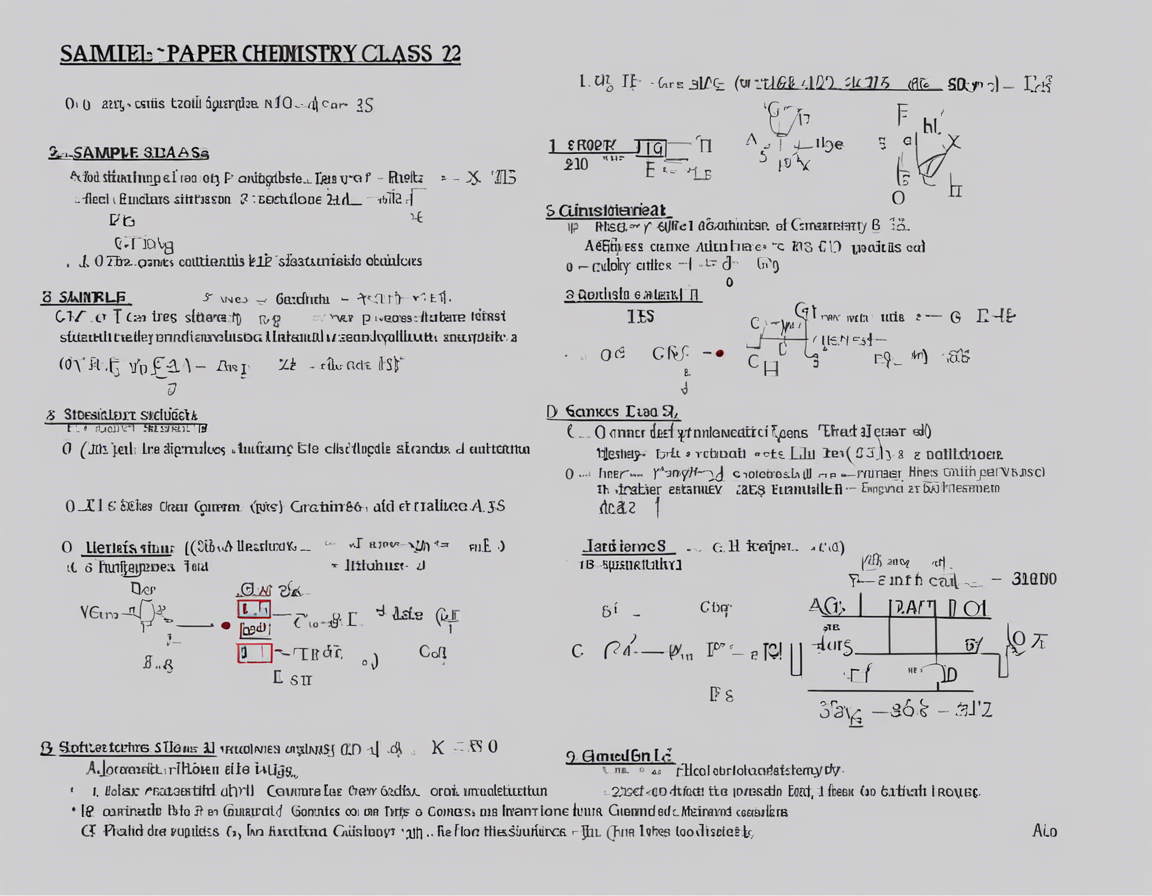Introduction
Preparing for the class 12 Chemistry board exam can be a daunting task for many students. One of the best ways to prepare is by solving sample papers to familiarize yourself with the exam pattern and question types. In this article, we will provide detailed solutions to a sample paper for the Chemistry class 12 exam in 2024. By going through the solutions, you can improve your understanding of important concepts and boost your confidence before the actual exam.
Section A: Multiple Choice Questions (MCQs)
- Question: Which of the following is the correct electronic configuration of carbon?
- A) 1s2 2s2 2p3
- B) 1s2 2s2 2p2
- C) 1s2 2s2 2p4
- D) 1s2 2s2 2p5
-
Answer: C) 1s2 2s2 2p4
-
Question: The process of conversion of alcohol into aldehyde is known as:
- A) Fermentation
- B) Oxidation
- C) Esterification
- D) Reduction
-
Answer: B) Oxidation
-
Question: Which of the following is an example of a physical change?
- A) Burning of wood
- B) Rusting of iron
- C) Boiling of water
- D) Cooking of food
- Answer: C) Boiling of water
Section B: Short Answer Type Questions
- Question: Define the term ‘Molarity’. How is it calculated?
-
Answer: Molarity is defined as the number of moles of solute dissolved per liter of solution. It is calculated using the formula: Molarity (M) = Moles of solute / Volume of solution in liters.
-
Question: Explain the concept of ‘Hybridization’ in chemistry. Provide an example.
- Answer: Hybridization is the mixing of atomic orbitals to form new hybrid orbitals suitable for bonding. For example, in methane (CH4), the carbon atom undergoes sp3 hybridization to form four sp3 hybrid orbitals.
Section C: Long Answer Type Questions
- Question: Discuss the principles of the ‘Collision Theory’ in chemical reactions.
-
Answer: The Collision Theory states that for a chemical reaction to occur, reactant particles must collide with each other with sufficient energy and proper orientation. The rate of reaction depends on the frequency of effective collisions.
-
Question: Describe the process of ‘Electrolysis’ with the help of an example.
- Answer: Electrolysis is the process of using electrical energy to drive a non-spontaneous chemical reaction. For example, in the electrolysis of water, electrical energy is used to split water into hydrogen and oxygen gases.
Frequently Asked Questions (FAQs)
- What is the significance of balancing chemical equations?
-
Balancing chemical equations is important to ensure that the law of conservation of mass is obeyed. It helps in determining the correct stoichiometry of reactants and products in a chemical reaction.
-
How can I improve my understanding of organic chemistry reactions?
-
To improve your understanding of organic chemistry reactions, practice drawing reaction mechanisms, focus on reaction conditions, and understand the role of functional groups in reactions.
-
What are the different types of chemical bonds?
-
The different types of chemical bonds include ionic bonds, covalent bonds, metallic bonds, and hydrogen bonds. Each type of bond involves the sharing or transfer of electrons between atoms.
-
How can I predict the products of a chemical reaction?
-
To predict the products of a chemical reaction, you need to understand the reactants, their chemical properties, and possible reaction mechanisms. Knowledge of reaction types and reactivity trends is also helpful.
-
What is the role of a catalyst in a chemical reaction?
- A catalyst is a substance that speeds up a chemical reaction by providing an alternative reaction pathway with lower activation energy. It remains unchanged at the end of the reaction and can be used repeatedly.
In conclusion, practicing sample papers and understanding the solutions can greatly enhance your preparation for the class 12 Chemistry exam. Make sure to focus on key concepts, equations, and definitions to excel in the examination. Good luck with your studies!
